January 22nd-28th 2012
Writtle Forest : This is an area close to my heart as I have been walking its woodlands since I was a boy in the 1960s. At that time there was quite a lot of coppicing going on, much of it - or so I was told - to supply the raw material for the manufacture of toilet rolls; since superseded by recycled newspaper! Since then there has only been limited, small scale coppice work, much of it carried out by local Woodsman, Martin Bacon, in the 1980s and 1990s. When, sadly, Martin died at a relatively young age even those woods where he had been working, such as Stoneymore and Deerslade, fell into a rapid decline. Most of the Forest woodlands are now derelict; it is possible to see for hundreds of yards through the trees with narry a bush or even a patch of bramble to break the view and the mature oaks have even begun to kill off the Hornbeam coppice with their dense shade. Deer are often blamed for the loss of undergrowth in woodlands, and they are a problem, but at Writtle the lack of coppicing has been the driving force behind its demise. Recently, though, the Forestry Commission have taken an interest in the area and notice boards explaining the Forest's history, management, and its importance to wildlife have been placed at the entrance to some of the woods.
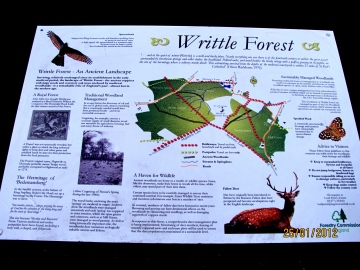
Imagine my joy, therefore, when - during a walk on Friday - I discovered that commercial coppicing had resumed in Deerslade.
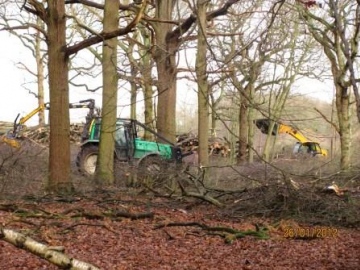
A fellow walker remarked that the site looked like a 1st World War battlefield but to me those stacks of timber, piles of brash and churned up woodland floor were a thing of beauty! I look forward to returning a few months hence to see what plants and other wildlife have begun - even in that short period of time - to respond to the inrush of light beneath the trees.
There are 32 species of bird that have declined by between 80% and 100% in the Ingatestone/Highwood area since the 1939-45 War, most of them from the 1970s onwards. Lack of coppicing has certainly played a part in the demise of several woodland species but today, as I left the woods behind me, I encountered one of the few that have increased since that time. Two pairs of Buzzards were engaged in a ritualistic territorial dispute that involved much 'mewing' (a wonderful sound), sky diving and competing between males to see who could soar higher than the other. It is neither a sight nor sound that I could have dreamed of witnessing locally when I was a boy, a time when the Buzzard was a rare vagrant to the County and they bred no closer than Devon.
The larger fungi now seem to be confined to those few species that can endure our winter weather. A walk between St Lawrence Bay and Bradwell St Peter's on 22nd produced sightings of Wrinkled Peach Rhodotus palmatus and Velvet Shank Flammulina velutipes on dead elms alongside the seawall and Scurfy Twiglet Tubaria furfuracea growing on the debris beneath them while the log pile in my garden yielded the Winter Polypore Polyporus brumalis and Bitter Oysterling Panellus stipticus.
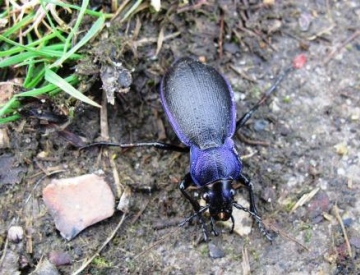
The first Daffodil of the spring was in bloom in the garden on 25th and a nearby Viburnum attracted the first bumblebee, the Buff-tailed Bombus terrestris, which may live to regret its early emergence if the weather forecast for next week is correct. Another unexpected sighting was a fine Velvet Ground beetle, disturbed during a work party at The Backwarden EWT Reserve, Danbury on 28th. False rocky shores
I think this would be fascinating and important to investigate, as would the only natural rocky bit of Essex present at Harwich (I have no personal knowledge of this small piece of rocky coastline). Serious investigation of the biodiversity associated with this area and of the new habitat created by the use of granite rocks to reinforce the seawall defence at Holland-on-Sea would be very interesting and rewarding. This is not a field in which the Club currently has much expertise though, except for seaweeds through Ian Tittley, the County Recorder for this group. False rocky shores
Once an important pastime for me was angling and in following this sport I fished many
rivers, lakes, piers and coasts around eastern and southern England. Then my attention
turned to 'catching' fossil fish and think I might have found that more rewarding than hauling
out living forms. But residing close to the shore here in Holland-on-Sea, I still find interest in
seeing what the angling fraternity manages to catch. All along much of the sea wall here
we have the added protection of granite rocks, mostly shipped in from Norway, to add a
further line of defense to the concrete and steel fortifications. Thus the thought struck me
that we may have unintentionally changed the immediate ecology of the upper shore and
wave splash zones. That we now have a produced new habitats in place of the natural
sand, shingle and muddy environment. There was always breakwaters to provide anchorage
for sea weed, limpets and mussels, oysters too are locally abundant, but never were there
all the crevaces amongst this granite 'armour' to attract creatures that might have previou-
sly stayed clear of our East Anglian shoreline. Perhaps it would be both interesting and
useful to know how significant has been the effect of these rock installations on the marine
wildlife of our low lying Essex shores.
In my angling days when fishing off Dorset and Devon rocks, Wrasse were common amongst
the catches, but speaking to one angler taking part in a local competition here, he informed
me that he had recently taken two of these fish from off our sea wall. Significant? January 15th -21st
A cold, crisp start to the week and a milder, grey, often wet end to it. Alder catkins have now joined those of Hazel in adding their pollen to the breeze while a precocious cock Blackbird was making its contribution to the dawn chorus of Song Thrushes, Dunnocks, Robins, Great Tits and occasional Mavis on 18th. Also getting ahead of themselves were a couple of buck Hares, whose ears were being soundly boxed by an indignant doe at Blue House Farm on 17th. The fungi season is just about hanging on , finds this week including the Branching Oyster Pleurotus cornucopiae on fallen elms at Holbrook Bay, on the Suffolk side of the Stour, and Oyster Mushroom P. ostreatus, growing on the wooden roof of a bus shelter in London Road, Chelmsford, where it was first reported by the County Recorder, Tony Boniface, in an article in the Field Club newsletter a couple of years ago. There was not much insect activity this week apart from this Black-spotted Longhorn Beetle, which was disturbed during a work party at Spring Wood EWT Reserve, Danbury on 21st. Initially identified from an article on Longhorns by Andrew Duff in the August 2007 issue of British Wildlife magazine it has since been confirmed by Peter Harvey. The larvae live in rotting oak stumps, of which there are plenty at Spring Wood, and we found what was probably one of these - a plump white maggot with a rusty brown head and jaws - when one of the stumps was inadvertantly 'brush cut'. It was carefully replaced beneath the loose bark from where it had fallen.
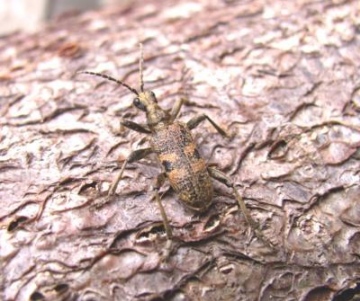
There has recently been a huge influx of sprats into the estuaries and they have brought with them many of the birds that follow the shoals offshore throughout the winter. Over 1500 Kittiwakes - a normally oceanic gull - passed Southend Pier on 19th, heading upstream, while there have also been reports of large numbers of Red-throated Divers in the Blackwater estuary along with a scattering of auks - Guillemots and Razorbills. A dark phase Arctic Skua was also seen at Southend, where it was watched harrying a juvenile Kittiwake until the latter was forced to regurgitate its last meal, the skua deftly catching the fish before it hit the water. Another highlight was a Grey Seal - a scarce species in Essex - and the first I have seen in the County.
Finally, and sadly, a number of oaks at The Backwarden EWt Reserve, Danbury, have recently been diagnosed as suffering from Acute Oak Decline, a disease that is on the increase in this part of the world. The most obvious symptoms are vertical lesions on the bark, from which a black, tar-like substance oozes. No one seems to be quite sure what causes it but it may be a bacterial infection. A few species of beetle take advantage of the tree's decline by laying their eggs under the bark; these infestations may hasten its demise but the beetles are not thought to spread the disease. Infected trees invariably succumb but often display little foliage loss until the last stages of the disease. It infects old and adolescent trees alike and can kill up to half the oaks on a site. If it does continue to spread and reaches the farmland landscape then some of our grandest oaks could go the same way as the elms before them - a depressing thought. January 8th to 14th
Balmy winter weather prevailed for most of the week, turning to sunshine, followed by overnight frosts on Friday and Saturday. Like Mary, I found both Wood Blewits Lepista nuda (Stow Maries Halt EWT Reserve) and Field Blewits L. saeva (Althorne) during the week (the former still in edible condition) while other species defying the season have been Russula silvestris, also at Stow Maries, and Petticoat Mottlegill Panaeolus papillonaceus on cow dung at Blue House. The former, which grows under oaks, was once considered to be con-specific with The Sickener R.emetica, which occurs with conifers, but has since been split. The taste is similar though - fit to skin your tongue!
The garden moth trap produced a Chestnut on 8th while other members of the Essex Moth Group have reported both Red Admiral and Peacock on the wing and Angleshades, Dark Chestnut, Satellite, Hebrew Character and Silver Y in their traps, the last named surely a survivor from last autumn's migration. Another likely lingerer from last year was a Common Wasp at Stow Maries, not a queen but an ordinary working-class individual! We also disturbed this hibernating Hawthorn Shieldbug Acanthosoma haemorrhoidae while clearing scrub on the reserve. An Irish Yellow Slug also took refuge in my moth trap one night, a species first identified for me last year by EFC recorder, Simon Taylor. It actually hails from the Baltic states but was first recorded from these isles in Eire, hence it's name.
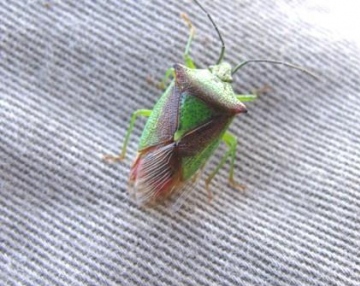
Recorded 25 species of wild flower in bloom during the first week of the year compared with only three during the same period last year, not surprising considering the bitter weather in December 2010. Among them have been most of the regular garden weeds including Hairy Bittercress and Petty Spurge plus more unlikely candidates such as Musk Storksbill (naturalised at a couple of sites in Ingatestone), Wild Carrot, Fennel, Red Campion and Shining Cranesbill. Hazel catkins have also been shaking their pollen on to the breeze for the first time this winter. The highlight for me - although not found in bloom - was my first parish record of Milk Thistle, a rare event now that the number of vascular plants recorded from the area is well over 600. It's probably about time I wrote a Parish Flora for the EN, assuming that is they would publish it!
Birds seen this week included up to 200 Redwings feasting on the last of a bumper crop of holly berries at The Backwarden EWT Reserve and single pairs of Treecreeper in three of the woods at Writtle Park, a species which I need to see in order to record nowadays as I can no longer hear their thin, high pitched calls! There have also been a good number of raptors on display at Blue House including up to 6 Buzzards soaring over the Woodham-Burnham ridge, 2-3 Marsh harriers, a female Hen Harrier, Sparrowhawk and Merlin while a pair of courting Peregrines have been upsetting all and sundry, the tiercel demonstrating his prowess by making spectacular, 100mph stoops at prey both real and imaginary! Blue-legs and Wood Blewits
I have just been for a quick walk today in the bright but frosty weather, where most of our lawn still has ice on it at 3pm, so we have no fungi here. But within 400m of my home I found two collections of Blue-legs (Field Blewits) and one collection of Wood Blewits, all frozen solid but very recognisable. I did not quite fancy them for tea, but it does show how our fungi that usually fruit in the autumn are now continuing into spring! January 1st-7th 2012
A wander round the garden at dawn on the 1st revealed a single Snowdrop and Crocus in bloom on the rockery. The latter was the old fashioned pale blue variety that belly flops at the onset of the first decent breeze. There proved to be plenty of "decent breezes" this week, as the disappearance of two fence and three greenhouse panels into a neighbour's garden testifies!
Mill Green Common : Much of the former heath has been overrun by secondary woodland in the past few decades, resulting in a disastrous loss of species diversity, the remaining mix of heather and gorse being confined to a small triangle of land opposite The Cricketers pub. This too is now under attack by birch saplings, some already twenty feet tall, and during the last two winters Rob Smith - the EFC Butterfly Recorder - and myself have been attempting to stem the tide. Several of the birches were cut down in the past and have coppiced into multi-stemmed stools. We had been hoping to poison the stumps but there are health and safety issues when using such chemicals in public places. Those we re-coppiced last winter were sprouting well by early March and I fully expected the young coppice to be three feet tall by the time we resumed work in November. Fortunately, the large local deer population came to our rescue. Much maligned for destroying the shrub layer in coppiced woodlands they did us a favour by constantly nibbling the young growth throughout the summer, eventually killing the stools. By early spring this year we should have got the invasive birch under control and hope that the two large clearings created will eventually be re-colonised, if not by Heather then at least by Gorse, as even decent stands of the latter are all but gone from the Writtle Forest area. Already, last year's clearing has been colonised by three species of heath-land grasses, Purple Moor, Tufted Hair and Mat Grass, together with large quantities of Sheep's Sorrel, so things are looking hopeful.
The dead birch stools have sprouted large numbers of Turkey Tail Trametes versicolor and Tripe Fungus Auricularia mesenterica while the pleasantly mild and damp weather so far this winter has meant that several species of fungi, usually long since killed off by the frosts, have continued to fruit into the New Year. Finds this week have included three kinds of Clitocybe - Clouded and Winter Funnels C.nebularis & C.metachroa at Waterhall Meadows, Little Baddow, and Trooping Funnel C.geotropa, at Fryerning. The Deceiver Laccaria laccata is still fruiting on my garden lawn and Honey Fungus Armillaria mellea agg is polishing off what little remains of my peach tree. At The Backwarden EWT Reserve Common Earthballs Scleroderma citrinum were still pumping spores into the air on 4th and among a number of little brown jobs growing on fallen branches that I did my best to ignore was one I recognized, namely, Angel's Bonnet Mycena arcangeliana. The best finds of the week, though, were at Fryerning Churchyard - a large group of Grey Knight Tricholoma terreum (illustrated) and the Honey Waxcap Hygrocybe reidii, which, as its name suggests, smells of honey - or so the person I asked to smell it informs me. Having no sense of smell I have no idea what honey smells like!
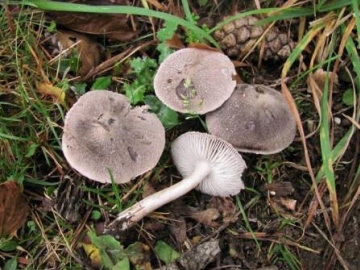
Despite the mild weather there are few insects to be seen yet. The garden moth trap yielded a Mottled Umber on 1st, we disturbed several 7-spot Ladybirds while working at Mill Green on 2nd and flushed the winter flying micro moth Agonopterix heracliana at The Backwarden on 4th. It's been a good week for birds, though; highlights being a flock of 100+ Siskins feeding in Alders at Harding's Farm, Ingatestone on 1st, a Peregrine (a scarce bird inland in Essex) at The Backwarden on 4th and a Black-necked Grebe and a delightfully tame Lapland Bunting at Blue House Farm EWT Reserve on 6th
Happy New Year! |
|
Archives:
May 2020
Aug 2019
Jan 2019
Sep 2018
Jul 2016
Oct 2015
Jul 2015
May 2015
Apr 2015
Mar 2015
Feb 2015
Jan 2015
Dec 2014
Oct 2014
Sep 2014
Aug 2014
Jul 2014
May 2014
Apr 2014
Mar 2014
Feb 2014
Jan 2014
Dec 2013
Nov 2013
Sep 2013
Aug 2013
Jul 2013
Jun 2013
May 2013
Apr 2013
Mar 2013
Feb 2013
Jan 2013
Dec 2012
Nov 2012
Oct 2012
Sep 2012
Aug 2012
Jul 2012
Jun 2012
May 2012
Apr 2012
Mar 2012
Feb 2012
Jan 2012
Dec 2011
Nov 2011
Oct 2011
Sep 2011
Aug 2011
Jul 2011
Jun 2011
May 2011
Apr 2011
Mar 2011
Feb 2011
Jan 2011
Dec 2010
Nov 2010
Oct 2010
Sep 2010
Aug 2010
Jul 2010
Jun 2010
May 2010
Apr 2010
Mar 2010
Feb 2010
Nov 2009
Oct 2009
Aug 2009
Jul 2009
Jun 2009
May 2009
Apr 2009
Mar 2009
Feb 2009
Jan 2009
Nov 2008
Oct 2008
Sep 2008
Aug 2008
Jul 2008
Jun 2008
May 2008
Apr 2008
Mar 2008
Feb 2008
Jan 2008
Dec 2007
Nov 2007
current posts
|
























